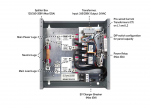Sierrasparky
Senior Member
- Location
- USA
- Occupation
- Electrician ,contractor
I got a call to install one of these for a condo unit owner. It is a device that allows shedding of the EV charger when load on the customers 100 amp feeder reaches a certain limit. As per the instructions you intercept the feeder and place this device. It has a Load breaker to supply the EV charger. The issue I have is the recommended installation.
1- the breaker for the EV is located within a enclosure with SCREW cover. ( not readily Accessible).
2- Does the EV need a disconnect ? If the breaker is (readily Accessible). then can serve as the disco.
3- Instructions say it can be mounted on the ceiling. How is the breaker inside readily Accessible?

 dccelectric.com
dccelectric.com

1- the breaker for the EV is located within a enclosure with SCREW cover. ( not readily Accessible).
2- Does the EV need a disconnect ? If the breaker is (readily Accessible). then can serve as the disco.
3- Instructions say it can be mounted on the ceiling. How is the breaker inside readily Accessible?

DCC-9 The Best Solution for Electric Vehicle Charging in Condos
EV Charging installations made possible in condos by DCC-9. Allows for direct utility billing to the unit and avoid major infrastructure upgrades.




